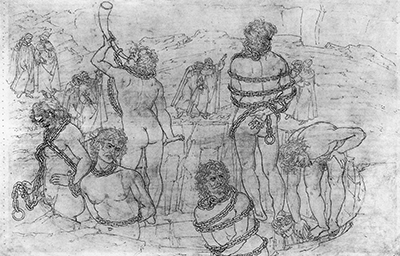 Buy Art Prints Now
Buy Art Prints Nowfrom Amazon
* As an Amazon Associate, and partner with Google Adsense and Ezoic, I earn from qualifying purchases.
Inferno, Canto XXXI represents the raw power of nature as the giants of antiquity rise up against the gods
The punishment for their crimes was to be placed in chains, as Botticelli captures in this illustration which accompanies Dante's chapter.
The content in this text gives Sandro Botticelli the ideal opportunity to display his anatomical skills as a draughtsman, adding multiple figures across the composition. Few Renaissance artists have held the same qualities as Botticelli, but Raphael, Michelangelo and Leonardo da Vinci can certainly claim to have reached this level.
Canto XXXI was part of Botticelli's Dante's Divine Comedy series of illustrations to accompany the written texts. Each one would therefore follow similar dimensions in order to accurately fit the final manuscript. The vast majority of these drawings can now be found in Berlin after a significant sum was paid in the 19th century to bring them to Germany from a private collector in the UK.
Canto comes from the word for song in Italian and represents how each chapter in the manuscript was treated as a separate chapter. Each four column text would be joined by Botticelli's corresponding sketch. Whilst there was little critical acclaim at the time of their release, these drawings have since gained significant praise from art academics. Illustration for literature has also become a more respected use of an artist's talents.



